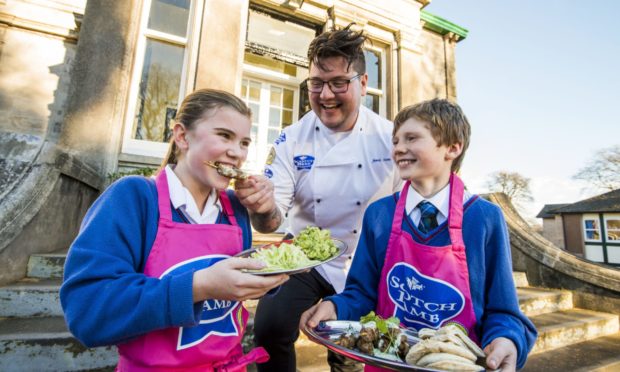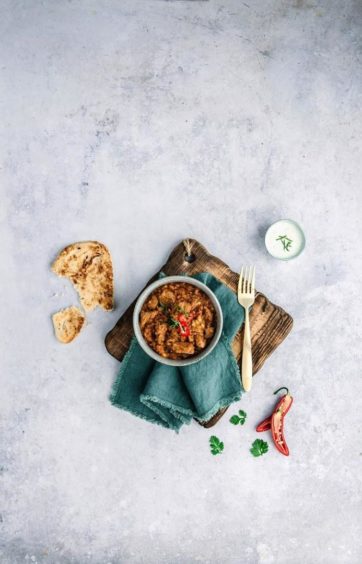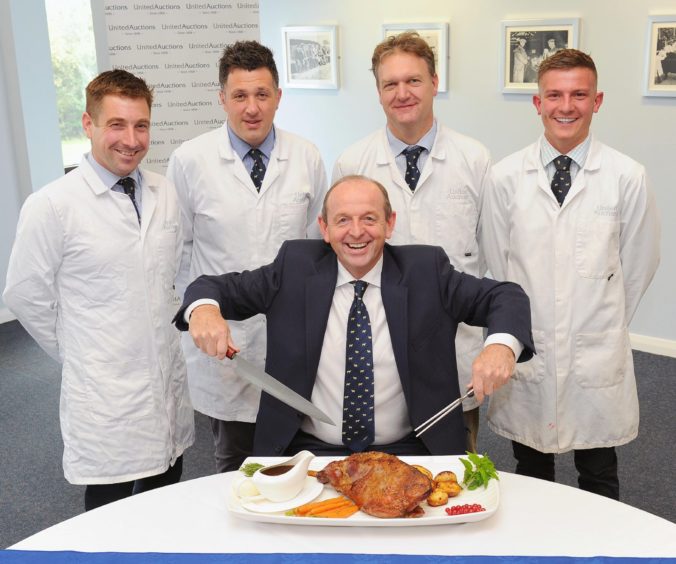Pupils at local schools will be learning how to love lamb thanks to a huge donation of meat.
More than 9,800 school children throughout Scotland will be cooking and eating lamb donated by the country’s livestock auction marts next week as part of “Make It Lamb for St Andrew’s Day”.
Pupils from Harris Academy Dundee, Craigie High School Dundee, Carnoustie High School, Forfar Academy, Webster’s High School Kirriemuir, Dunfermline High School, Kinross High School, Perth High School and St John’s Academy Dundee are among 114 schools taking part.
They will be cooking recipes with lamb, from pizza to lamb dhansak, created by Quality Meat Scotland (QMS), in home economics classes and school canteens. Donations from the marts, farmers and consultants have exceeded 1.25 tonnes of butchered lamb which will be delivered this week.
The Make It Lamb for St Andrew’s Day campaign, supported by the Institute of Auctioneers (IAAS), John Scott Meat (JSM), Quality Meat Scotland (QMS), NFU Scotland (NFUS) and the National Sheep Association Scotland (NSAS), builds on the work of auction mart, United Auctions which, since 2012, has been promoting lamb as the meat of choice for St Andrew’s Day on November 30.
Natural product
George Purves, from United Auctions, who came up with the idea, said: “Scots are pretty much beef eaters, we don’t each very much lamb that we produce. We tend to sell it south and sell it abroad. We are missing on a really good natural product that is reared on grass and its mother’s milk and full of omega 3.
“We came up with the idea during the rural leadership course in 2009 and I recall they were saying on the radio that the Irish celebrate St Patrick’s Day very well, but we don’t really know what to do on St Andrew’s Day.
“Having been a sheep auctioneer for years, I thought the two linked up very well. St Andrew’s Day is at the end of November when it’s very seasonal for lamb and it’s quite reasonably priced at that time of the year too.”
The aim of the Make It Lamb for St Andrews Day campaign is to encourage everyone in Scotland to make Scotch Lamb the dish for the national patron’s day, in the same way that haggis is synonymous with Burns Night and turkey with Christmas.
“Turkey is associated with Christmas, haggis is associated with Burns Night and those that enjoy haggis eat it throughout the year because of Burns Night so I thought if we could get the Scots to at lamb on St Andrew’s Day, those that would enjoy it would eat it at other times of the year,” continued George.
Campaign resurrected
The campaign was initially promoted a few times after the course before being resurrected last year.
George added: “We ran it after the rural leadership course, but a couple of years ago we had a school visit to the market, when there were about 60 of them in the class. We took them up for their lunch and they produced all their packed lunches and it was really disappointing to see what they were having for lunch.
“I asked them how many of them had tasted lamb? There were only six out 60 who had tasted lamb and the teacher hadn’t tasted it either.
“With Brexit looming now, too, I thought it was time we did something about it so we cranked it up. My fellow director, Chris Sharp, put a lot of work into resurrecting it.
Spike in demand
“We did a few events at rugby clubs last year putting on lunch for St Andrews’s Day, a few village halls and pubs and restaurants took it up as well and there was a spike in the demand for lamb. The butchers said they were busier and noticed a difference where we were promoting it.
“We got QMS on board early this year to help spread the gospel and their marketing team helped us enormously.
“We have lamb going into more than 100 high schools into their home economic classrooms and they are going to be cooking lamb and get the chance to taste it. We reckon around three-quarters will be tasting it for the first time.
“We have been really encouraged by the response and we hope they enjoy it once they have tasted it and will look forward to eating it at other times of the year.”
This year, IAAS has asked both their members, the marts and farmers to donate lamb for schools, which has been generously supported and allowed the campaign to grow.
QMS has developed a series of recipes to inspire the nation and demonstrate how versatile and easy lamb is to cook with, including a lamb curry by celebrity Edinburgh chef Tony Singh MBE.

Generosity
Alix Ritchie, education manager at QMS, who works with teaching staff across Scotland, said: “The marts and farmers have been incredibly generous.
“Donating lamb like this allows us, as an industry, to reach a huge number of young people and to inspire and educate them about the role of red meat as part of a healthy balanced diet.
“They can find out first-hand that it is nutritious, full of flavour and can be super quick to cook, whether it’s pizza, a curry or steaks.
“It’s one of the meats that often school teachers who have a limited budget very often buy to cook with in schools. We found that working with the teachers that it is one of the barrier meats because often it is too expensive.
“For the children to be able to cook with lamb and then to taste what they’ve cooked is really exciting. Lamb is sustainable, it’s tasty, it’s Scottish and it’s given them a chance to taste something they haven’t already and when we are in schools it’s amazing how few children have actually tasted lamb. It gives children the opportunity to taste one of the most wonderful products.”
Popular initiative
Alix, who as well as her outreach role farms at Montalt Farm just outside Dunning in Perthshire, had an inkling that the campaign would prove popular with home economics teachers who have strict budgets to adhere to.
“When Chris (Sharp of United Auctions) got in touch and said this was something they wanted to do I did warn him that this was going to be very popular. If you say to cash-strapped schools that we will buy meat for you to cook with your pupils then they are going to be delighted with that,” she revealed.
“The teachers who have got back to me are delighted because it is allowing them to cook something that they would never have had the chance or the budget to do and the teachers are really grateful for the opportunity.
“There are two recipes they are going to be making – lamb dhansak and lamb pizza. A lot of the teachers have done a voting system to allow the pupils to decide which one they are going to make and I’m guessing the pizza will probably be more popular but we will wait and see.
“Some teachers are tying it in with the curriculum and some are tying it in with their lessons so we have had a teacher who has got in touch to say they are studying food sustainability with their S3 class.
“This is an excellent opportunity for them to look at sustainability, food miles and what is being produce locally and seasonally and tie that in with the cooking of the lamb.”
Lamb Dhansak 🏴🧑🏼🍳👨🏻🍳👩🏻🍳👩🏼🍳🥩🌶 #lambforstandrewsday #lambdhansak #foodie @ScotchKitchenSc @qmscotland @ScotchKitchen pic.twitter.com/3n98MwHhnx
— EA Home Economics (@ElginAcHE) November 24, 2020
New resource
With the opportunity to go out and visit schools not available during the Covid-19 lockdown, Alix and her colleague, Jennifer Robertson, have devoted their time to building a new resource.
“For a long time we have been wanting to create an interactive resource that’s digital, but with our normal day to day work of going into schools and talking at events we have never had the time to do that, but as we have not been able to go into schools it gave us an opportunity to do this,” continued Alix, who previously worked with the Royal Highland Education Trust.
“And this weekend we have launched Farming Foodsteps which is an interactive resource which will support secondary teachers around the learning and it looks from farm to fork, from field (sustainability) to food production looking at processing, labelling and careers, to health and how red meat can be part of a healthy balanced diet and fork – the cooking and the nutrition as well.
“That has just launched and already the feedback has been positive both from industry and teachers we have spoken to.”
Schools and pupils can share their cooking and eating experiences by using the hashtag #LambforStAndrewsDay and tagging @IAASscotland, @qualitymeatscotland and @scotchkitchen on Facebook; @iaas_scotland, @qmscotland and @scotchkitchen on Twitter; @scotchkitchen and @qmscotland on Instagram.
We are excited to announce that Farming Foodsteps is now live! @qmscotland's new, interactive educational resource explores the journey Scottish red meat makes from farm to fork. Take your first Farming Foodsteps today – https://t.co/p7Kr83kk4J… pic.twitter.com/BpIv7qdaGG
— Scotch Kitchen in Schools (@ScotchKitchenSc) November 21, 2020
Red meat sales strong
The campaign comes as it was revealed butchers remain one of the strongest red meat retailers in Scotland, even as consumers return to pre-lockdown shopping habits according to new statistics from Quality Meat Scotland (QMS).
Across Scotland, butchers have seen more than 20% increase in value in year-on-year sales, and reports from the last few weeks suggest that this continues to strengthen. Large retailer figures also show steady growth in red meat sales.
The latest figures analysed by QMS show that of overall unprocessed red meat sales, butchers are still seeing a 21.7% increase in value in sales and are up 13.2% volume over last year, compared to the rest of the market which is averaging +12.8% in value and 9.3% in volume*.
Gordon Newlands, QMS brands development manager, said: “Butcher trade peaked during the first lockdown in April and May and became the second highest retailer of red meat. This corresponded with more consumers choosing to buy local, whether to avoid the supermarket, for convenience or having more time or inclination to go to the butcher.
“The trend has continued, even as shopping habits have seen more consumers returning to the larger retailers, and we anticipate it will carry on through Christmas. Although reports show that customer numbers have remained similar since June, spend seems to be higher per transaction especially since the tiered lockdown was announced.”












